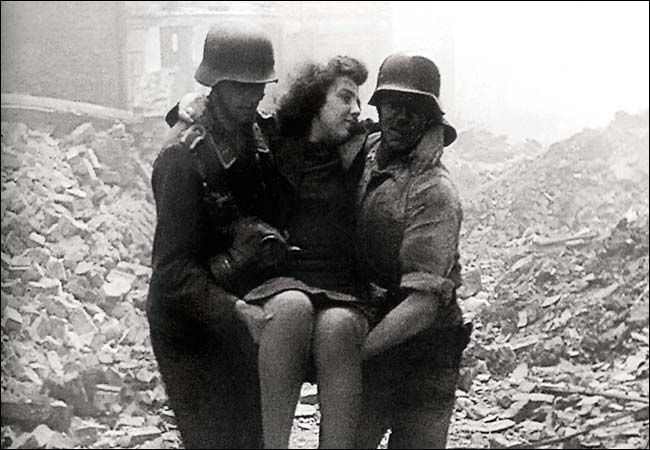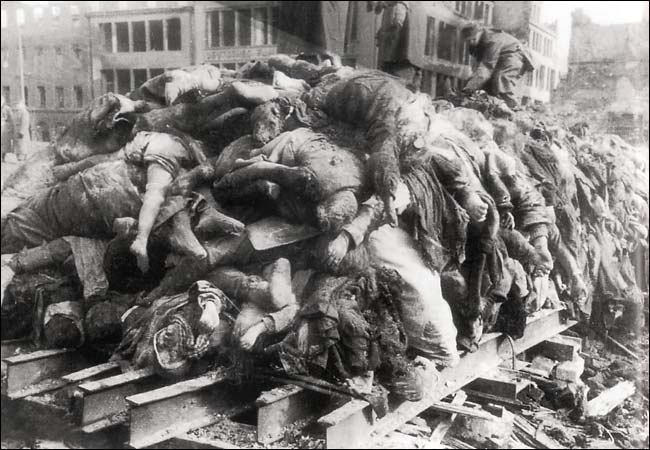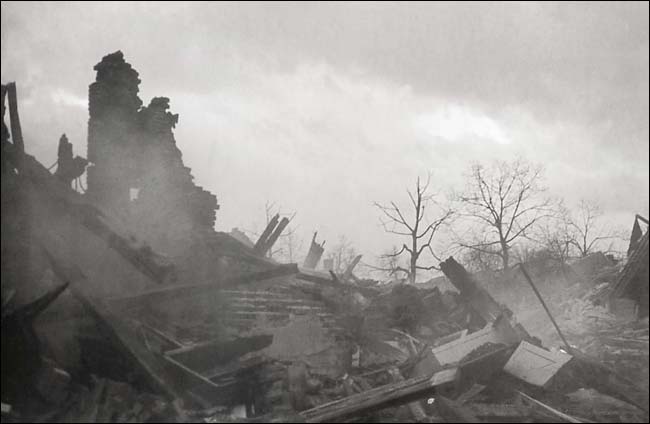| Want to send this page or a link to a friend? Click on mail at the top of this window. |
| Posted December 6, 2003 |
 |
From "Brandstätten" (Places of Fire") by Jörg Friedrich |
| War-ravaged Berlin in 1943 as seen 1943 as seen in Jörg Friedrich's new book. |
| Photographs That Cry Out For Meaning |
| By MICHAEL KIMMELMAN |
In "Brandstätten" ("Places of Fire"), a new book by the historian Jörg Friedrich, we see a photograph of a seated woman.
I think. Is it a woman?
Assuming it is, she has a child on her lap. The child is perhaps 3 or 4 and wears an overcoat with big buttons. The woman's head is facing up (heavenward), her mouth wide open. She wears a cape with a hood, which surrounds her like a halo. Behind her are two figures.
Mother and child with two saints. Or so you might think, except that the figures are incinerated. Their corpses are lightly dusted with rubble. The backdrop is a collapsed wall. The caption says, "Hamburg, July, 1943."
Some years ago the art critic John Berger wrote about the violence that is in all photographs shot by strangers, what he called public photographs, as opposed to private snapshots, which we take for ourselves and are continuous with our own memory. Public photographs "carry no certain meaning in themselves," he wrote. They are "like images in the memory of a total stranger," lending themselves "to any use."
Presumably a photojournalist or a German official shot the picture in Hamburg. Without the caption in the book, we would not know that it was Hamburg or 1943. It could be a picture of any conflagration. It could be put to any use.
In this case it is being used to recover a supposedly neglected and contested part of modern military history. Mr. Friedrich is following in the footsteps of the writer W. G. Sebald, who died in 2001. In his last book, "On the Natural History of Destruction," based on lectures he gave in Zurich in 1997, Sebald addressed a "scandalous deficiency": what he perceived as a self-imposed silence by Germans after World War II about the effects of Allied bombings on German civilians and cities.
Against this "collective amnesia," Sebald, a Trümmerkind, a child who grew up in the ruins, tried to piece together what had transpired during the war. The bombs on Hamburg, Sebald recounted, caused a firestorm that rose miles into the air, sucking oxygen, lifting roofs off of buildings and rolling at a tremendous speed, "like a tidal wave through the streets."
Mr. Friedrich's "Places of Fire" is a collection of photographs of Germany during the war, visual traces of Sebald's missing history. Mr. Friedrich is mysterious about their origin. They seem to have been amassed by the country's efficient record keepers and collected in town archives. They show scenes of Nazis hauling corpses across the smoking ruins of bombed-out Dresden and Hitler Youth clearing dead children from streets in Cologne.
Mr. Friedrich, another Trümmerkind (like Sebald, born in 1944), published an earlier book, "Der Brand" ("The Fire"), which incited charges that he wished to portray Germans as victims and the British and Americans as war criminals. Now "Places of Fire" has caused even more criticism. The German newspaper Süddeutsche Zeitung recommended that readers throw it directly into the garbage.
At the encouragement of former Chancellor Helmut Kohl, Mr. Friedrich says, he included a few photographs showing the effects of Nazi bombing on British and Polish civilians, as a kind of balance. And he has responded that while the decision to publish the German photographs was difficult, Joseph Goebbels, the Nazi propaganda chief, "forbade these photos of our victims from the German papers."
"In a way we've obeyed his orders until this day," Mr. Friedrich said. "If you like looking at these photos, you're crazy and you need a doctor. But this is a matter of truth."
I leave Mr. Friedrich's motives, the question of German memory and the justification for the Allied attacks on German civilians for others to decide. Whether the history of these attacks has even been a taboo and repressed in Germany is a matter of debate among scholars. Goebbels's order was not universally obeyed. In any case at issue here are the creaky moral mechanics of photography, a visual art matter.
Photographs do illustrate a basic, unremarkable truth that war, like all forms of suffering, is terrible. But beyond that their relationship to reality is complicated.
It was the Nazis who first turned photography into a systematic form of propaganda. Photographs, it has often been said, both objectify and subjectify what they depict. They atomize time, disconnecting past from present. A picture may tell a thousand words, but words have ultimate power over photographs because each photograph is just a fragment: it needs words to assign it a context, and this context may change along with the message of the image. Advertisement
A dark, uncaptioned, black-and-white photograph of the crumpled remains of unidentified people scattered across a street accompanies Sebald's account of the Hamburg bombing. It is not clear what place the picture shows, or even that these are corpses, since they are burned beyond recognition. In the small photograph, they look almost like heaps of litter after a parade.
On the facing page Sebald cites a passage from the diary of a man named Friedrich Reck, who shortly before the end of the war was sent to Dachau by the Nazis and died there of typhus. Reck describes the exodus of several dozen refugees in Upper Bavaria from the Allied bombings, which were like those in Hamburg.
Reck recalls the refugees forcing their way onto a train. A cardboard suitcase "falls on the platform, bursts open and spills its contents," he says. "Toys, a manicure case, singed underwear. And last of all the roasted corpse of a child, shrunk like a mummy, which its half-deranged mother has been carrying about with her, the relic of a past that was still intact a few days ago."
 |
Photographs from "Brandstätten ("Places of Fire") by Jörg Friedrich |
| Bodies stached on a Dresden street. "If you like looking at these photos, you're crazy, and you need a doctor," says the author in whose book they appear. |
Not many years ago photographs turned up from Tuol Sleng, where the Khmer Rouge tortured and killed Cambodians during the 1970's. More than 14,000 people were imprisoned there. Seven survived.
Like the Nazis, the Khmer Rouge kept obsessive records, including mug shots of those they arrested, among them a mother cradling a baby; two men, shackled and blindfolded, holding hands; a boy, maybe 12 years old, hands bound behind his back, his expression perfectly calm despite the prison number safety-pinned directly into his bare chest.
He is a modern St. Sebastian. The Tuol Sleng photographs, like those in Mr. Friedrich's book, are unbearable. Does it alter their impact to learn that many of those killed at Tuol Sleng were themselves Khmer Rouge, as the dead in "Places of Fire" include Nazis?
Surely it does, but the photographs themselves remain morally neutral. A photograph in Mr. Friedrich's book, from Dresden, 1945, shows scores of limp, charred German corpses piled in a heap, precisely like the pictures of the murdered inmates at the extermination camps. The caption explains that after the Allied attack on Dresden, Russians built enormous pyres to incinerate the partly carbonized bodies.
Another picture, captioned "Battle of Berlin, 1943/44," shows two men wearing German uniforms hoisting a woman, seated in their arms, from a rubble wasteland. It can summon to mind, almost involuntarily, the much-reproduced photograph by Shannon Stapleton of Reuters, of five dust-covered rescue workers at the World Trade Center carrying out the Rev. Mychal F. Judge, a Fire Department chaplain, who had died in a rain of debris while ministering to victims when the towers collapsed, a modern-day Pietā.
Other pictures in Mr. Friedrich's book (presumably inadvertently) bear more associations with familiar art. A photograph of a young girl, kneeling, arms extended, weeping over the prone corpse of her sister, is a standard Entombment. A photograph of smoldering Berlin, in silhouette with trees against a leaden sky, looks uncannily like "Winter," by the German Romantic painter Caspar David Friedrich.
It is one of the basic truths of photographs that they inevitably beautify horror (in the process, cleansing the events they capture of unattractive sounds and smells). The writer Walter Benjamin noticed this. The camera, he perceived, "is now incapable of photographing a tenement or a rubbish heap without transfiguring it." It has succeeded "in turning abject poverty itself, by handling it in a modish, technically perfect way, into an object of enjoyment."
Enjoyment and beauty provoke sympathy. Images of Germany during World War II, which, consciously or not, we associate with other images already familiar to us, raise the essential point that Susan Sontag made years ago: "Contrary to what is suggested by the humanist claims made for photography, the camera's ability to transform reality into something beautiful derives from its relative weakness as a means of conveying truth."
 |
| War-ravaged Berlin in 1943 as seen in Jörg Friedrich's new book. |
To this I might add a final disturbance deriving from the presumption that photographs of suffering are shot as if in our name. War photographers show moments of agony that are meant to shock us, as sympathetic viewers, into a condition of moral alarm. Mr. Berger, the critic, located this condition in the discrepancy between what we see in the picture and our own (more fortunate) lives.
Shock registers as a feeling of "personal moral inadequacy." The viewer's "own moral inadequacy may now shock him as much as the crimes being committed in the war," Mr. Berger writes. In this instant the viewer may decide to shrug off the feeling as too familiar or perform an act of penance. In either case, "the issue of the war which has caused that moment is effectively depoliticized," he adds. "The picture becomes evidence of a general human condition. It accuses nobody and everybody."
So we stare at the sensational photographs in Mr. Friedrich's book with our beliefs about the war struggling to anchor images that threaten to come politically untethered before our eyes. The pictures beseech us to feel outrage while they exploit the amoral status of photography, with its deeply misleading reputation for truthfulness.
The only way to look at such pictures — because not looking is an unreasonable choice — is therefore to keep their equivocal status in mind. The meaning of words, while fungible like the meaning of photographs, can be easier to control. Sebald ends with a reminder that "the real pioneering achievements in bomb warfare" were by Germans.
The German Sixth Army had reached the Volga in August 1942, he points out, when 1,200 Nazi bombers descended in a single raid on Stalingrad, then swollen by refugees. "During that raid alone, which caused elation among the German troops stationed on the opposite bbank," he says, "40,000 people lost their lives."
Copyright 2003 The New York Times Company. Reprinted from The New York Times, Arts & Ideas, of Saturday, December 6, 2003.
| Wehaitians.com, the scholarly journal of democracy and human rights |
| More from wehaitians.com |